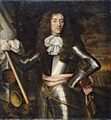Irish Confederate Wars facts for kids
Quick facts for kids Irish Confederate Wars orEleven Years' War |
|||||||
|---|---|---|---|---|---|---|---|
| Part of the Wars of the Three Kingdoms | |||||||
|
|||||||
| Belligerents | |||||||
| Phase I: October 1641 – September 1643 | Phase I: October 1641 – September 1643 | ||||||
| Phase II: September 1643 – June 1649 | Phase II: September 1643 – June 1649 | ||||||
| Confederate Civil War: July 1646 – June 1647 |
Confederate Civil War: July 1646 – June 1647 |
||||||
| Phase III: June 1649 – April 1653 | Phase III: June 1649 – April 1653 | ||||||
| Commanders and leaders | |||||||
Phase I:
|
Phase I:
|
||||||
Phase II:
|
Phase II:
|
||||||
Phase III:
|
Phase III: | ||||||
| Strength | |||||||
|
|
||||||
| Casualties and losses | |||||||
|
|
||||||
| Total: 200,000+ dead | |||||||
The Irish Confederate Wars, also known as the Eleven Years' War, took place in Ireland from 1641 to 1653. This conflict was part of a larger series of civil wars called the Wars of the Three Kingdoms. These wars involved Ireland, England, and Scotland, all ruled by King Charles I.
The war in Ireland had many causes. People fought over who should govern, who owned the land, and whether people had religious freedom or faced religious discrimination. A big question was whether Irish Catholics or British Protestants would hold power and own most of the land. Another key issue was if Ireland would be a self-governing kingdom under King Charles I or controlled by the English Parliament. This was the most destructive conflict in Irish history. It led to the deaths of 200,000 to 600,000 people from fighting, hunger, and disease.
The war began with the Irish Rebellion of 1641. Irish Catholics rebelled to take control from the English government in Ireland. They wanted an end to unfair treatment against Catholics. They also wanted more self-governance for Ireland and to reverse the Plantations of Ireland, where land was taken from Irish people and given to British settlers. The rebels also hoped to stop an invasion by anti-Catholic groups from England and Scotland. These groups were defying the king.
After the rebellion started, it became a conflict between Irish Catholics and English and Scottish Protestant settlers. The first few months saw attacks and killings on both sides, especially in Ulster.
In May 1642, Catholic leaders formed the Irish Catholic Confederation. This group controlled and governed most of Ireland. It included both Gaelic and Old English Catholics. For the next few years, the Confederates fought against Royalists (supporters of the King), Parliamentarians (supporters of the English Parliament), and an army from Scottish Covenanters. All sides used harsh tactics, like destroying crops and homes.
Disagreements about how to handle the Irish rebellion helped start the English Civil War in England in mid-1642. King Charles I secretly talked with the Confederates. This led to a ceasefire between the Confederates and Royalists in September 1643. In 1644, a Confederate army went to Scotland to help Royalists there. The Confederates kept fighting the Parliamentarians in Ireland. They won a big victory against the Covenanter army at the Battle of Benburb.
However, in 1647, the Confederates lost several battles to the Parliamentarians. These defeats happened at Dungan's Hill, Cashel, and Knockanuss. These losses made the Confederates agree to a deal with the Royalists. But this agreement caused arguments among the Confederates themselves. This internal fighting made it harder for them to prepare for a Parliamentarian invasion.
In August 1649, a large English Parliamentarian army, led by Oliver Cromwell, invaded Ireland. Cromwell's army captured many towns from the Confederate–Royalist alliance. After taking Drogheda and Wexford, Cromwell's army killed many soldiers and civilians. The Confederate capital, Kilkenny, was captured in March 1650. The Confederate–Royalist alliance was finally defeated when Galway was captured in May 1652. Some Confederates continued to fight a guerrilla campaign until April 1653. During this time, the English army killed many civilians and destroyed food supplies. They also brought an outbreak of bubonic plague.
After the war, Ireland was taken over by the English Commonwealth, which was a republic (a country without a king) that lasted until 1660. The practice of Catholicism was restricted. Most land owned by Catholics was taken away, and tens of thousands of Irish rebels were sent to the Caribbean or Virginia as servants. Many also joined Catholic armies in Europe.
Contents
The Rebellion of 1641
The war in Ireland started with the Irish Rebellion of 1641 in Ulster in October. During this time, many Scottish and English Protestant settlers were killed. The rebellion spread across the country. In 1642, at Kilkenny, the Association of The Confederate Catholics of Ireland was formed. This group organized the Catholic war effort.
The Confederation acted like an independent state. It brought together all kinds of Irish Catholic people, both Gaelic and Old English. The Irish Confederates said they supported the English Cavaliers (Royalists) during the civil wars in England. However, they mostly fought their own war to protect the interests of Catholic landowners.
The Confederates controlled much of Ireland as a self-governing state until 1649. They declared their loyalty to King Charles I. From 1642 to 1649, the Confederates fought against Scottish Covenanter and English Parliamentarian armies in Ireland. The Confederates were loosely allied with the English Royalists. But they disagreed about whether to send military help to the Royalists in England. They never sent troops to England, but they did send an army to help the Scottish Royalists. This started the Scottish Civil War.
The wars in Ireland involved many different groups fighting each other. The Protestant forces split into three main groups: English Royalists, English Parliamentarians, and Scottish Covenanters. This happened because of the civil wars in England and Scotland. The Catholic Confederates also split more than once. They argued about whether their main loyalty was to their Catholic religion or to King Charles I.
The wars ended with the defeat of the Confederates. They and their English Royalist allies were defeated by the New Model Army under Oliver Cromwell during the Cromwellian conquest of Ireland (1649–53). The wars caused a huge loss of life in Ireland. This was similar to the Great Famine of the 1840s. The English Parliament, which won the war, took away most of the land owned by Irish Catholics. This was a punishment for the rebellion and to pay for the war. Some land was returned after 1660 when the monarchy was restored in England. But this period marked the end of the old Catholic landowning class.
The Start of the Rebellion
The rebellion in October 1641 was meant to be a quick and mostly peaceful takeover of power in Ireland. A small group of plotters, led by Phelim O’Neill, planned it. Small groups of their relatives and followers were gathered in Dublin, Wicklow, and Ulster. Their goal was to capture important buildings like Dublin Castle.
There were only a few English soldiers in Ireland, so the plan had a good chance of working. If it had succeeded, the remaining English soldiers might have surrendered. This would have put Irish Catholics in a strong position to demand changes. They wanted civil reforms, religious tolerance, and self-government for Ireland.
However, the plot was discovered at the last minute. Because of this, the rebellion turned into chaotic violence. Once fighting began, the anger of the native Irish Catholic people against the British Protestant settlers exploded. Shortly after the rebellion started, O'Neill issued a statement called the Proclamation of Dungannon. He said he was acting on King Charles I's orders.
Early Fighting: 1641–1642
From 1641 to early 1642, the fighting in Ireland involved small groups. These groups were raised by local lords or among local people. They attacked civilians from opposing ethnic and religious groups.
At first, Irish Catholic groups, especially from Ulster, used the breakdown of law and order to get revenge on Protestant settlers. These settlers had taken Irish land during the plantations of Ireland. Initially, Irish Catholic gentry (landowners) tried to form militias to stop the violence. But when it became clear that the government in Dublin planned to punish all Catholics for the rebellion, they joined in the attacks on Protestants and fought English troops.
In areas where British settlers lived in large numbers, like around Cork, Dublin, Carrickfergus, and Derry, they formed their own militias. They defended themselves and managed to hold off the rebel forces. All sides were very cruel during this part of the war. About 4,000 Protestants were killed, and another 12,000 may have died from hardship after being forced from their homes. In one famous event, Protestant residents of Portadown were captured and then killed on the town's bridge. The settlers and the Dublin government responded with similar attacks on Irish Catholic civilians. Killings of Catholic civilians happened at Rathlin Island and other places.
The rebels from Ulster defeated a government force at Julianstown. But they failed to capture nearby Drogheda and were scattered when they tried to advance on Dublin.
By early 1642, there were four main groups of rebel forces. These were in Ulster under Phelim O'Neill, around Dublin (in an area called the Pale) led by Viscount Gormanstown, in the south-east led by the Butler family (especially Lord Mountgarret), and in the south-west led by Donagh MacCarthy, Viscount Muskerry.
The Confederates' War: 1642–1648
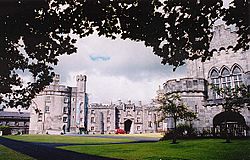
King Charles I wanted to control Ireland to use its resources against his enemies in England and Scotland. The Scots and their English Parliamentarian allies wanted to stop this. In 1642, 10,000 Scottish soldiers, paid for by Parliament, landed in Coleraine and Carrickfergus. English forces also regained control over Dublin.
Before the First English Civil War began, King Charles and Parliament agreed on a law called the March 1642 Adventurers' Act. This law funded the war in Ireland by promising to repay loans with money from selling lands taken from Irish rebels. This meant that neither side would accept the independent Catholic state that Irish leaders wanted. Both sides were committed to taking more land. Enforcing the Adventurers' Act was the main goal of the 1649 Cromwellian conquest.
This led to the formation of the Irish Confederacy, based at Kilkenny. By the end of 1642, it controlled two-thirds of Ireland. This included the ports of Waterford and Wexford, which allowed them to receive help from Catholic countries in Europe. Most Irish Catholics supported the Confederacy, especially the clergy. However, many upper-class Catholics were loyal to the King. They feared losing their own lands if the plantation settlements were overturned. Some fought against the Confederacy, while others, like Clanricarde, stayed neutral.
The Confederacy's first armies were mostly local militias and private groups. They were led by amateur aristocrats like Lord Mountgarret. These forces lost several battles, including Liscarroll, Kilrush, New Ross, and Glenmaquinn. But the start of the English Civil War in mid-1642 led to many English troops being called back home. This allowed Garret Barry, an Irish soldier who had returned from fighting abroad, to capture Limerick in 1642. The English soldiers in Galway were forced to surrender by the townspeople in 1643.
By mid-1643, the Confederacy controlled large parts of Ireland. The exceptions were Ulster, Dublin, and Cork. They were helped by divisions among their enemies. Some areas were held by forces loyal to Parliament, others by the Royalist Duke of Ormonde, and the Covenanters had their own plans around Carrickfergus. The situation was very complex, with loyalties constantly changing. For various reasons, many Protestant settlers in Ulster disliked the Scots. Some of their own allies in Parliament, including Cromwell, also felt this way.
A Standoff in the War
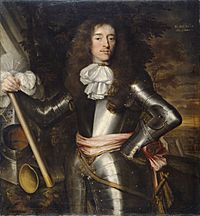
The English Civil War gave the Confederates time to build proper, full-time armies. They eventually had about 60,000 men in different areas. These armies were paid for by a system of taxation. They received supplies from France, Spain, and the Papacy. They were led by experienced Irish soldiers like Thomas Preston and Owen Roe O'Neill, who had served in the Spanish army.
However, some argue they missed a chance to conquer all of Ireland. They signed a truce, or "Cessation of Arms," with the Royalists on September 15, 1643. Then they spent the next three years in talks that didn't lead anywhere. From 1642 to 1646, the war mostly involved raids. All sides tried to starve their enemies by destroying crops and supplies. This caused many deaths, especially among civilians. The harshness of this period is shown by a Parliament law from October 1644. It said that no mercy should be shown to any Irishman or Catholic born in Ireland who fought against Parliament, whether at sea or in England and Wales.
An attack on Ulster in 1644 didn't make much progress. Meanwhile, the Royalists were clearly losing the war in England after their defeat at Marston Moor in July. Two weeks later, the Earl of Inchiquin switched his loyalty to Parliament. This gave Parliament control of the ports of Cork, Kinsale, and Youghal. In late 1644, the Confederates took Bandon, but Inchiquin kept control of Cork. Preston captured Duncannon in January 1645. He then tried to capture Youghal, but a lack of supplies forced him to give up the siege in March 1645.
People Forced to Move
The early years of the war saw many civilians forced to leave their homes. Both sides used tactics that would now be called "forced displacement." In the first part of the rebellion in 1641, vulnerable Protestant settlers fled to walled towns like Dublin, Cork, and Derry for safety. Others fled to England.
When Scottish Covenanter troops took over Ulster in 1642, they attacked Irish Catholic civilians in revenge for the attacks on settlers. As a result, it's thought that up to 30,000 people fled Ulster in 1642. They went to live in areas controlled by the Confederates. Many of them followed Owen Roe O'Neill's Ulster Army. They lived in clan-based groups called "creaghts" and moved their cattle herds with the army. Outside of Ulster, civilians were treated less harshly. However, the "no-mans-land" between Confederate and British-held areas in Leinster and Munster was often raided and burned. This also led to people leaving those areas.
Confederate Victories and Defeats
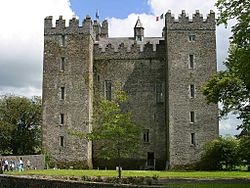
The stalemate broke in 1646. After the First English Civil War ended, the Confederate army tried to gain as much ground as possible in Ireland. They wanted to do this before the English Parliament's forces were expected to invade. They were quite successful in this effort.
On June 5, 1646, Owen Roe O'Neill defeated a Parliamentarian and Scottish army at Benburb. In July, Thomas Preston, leading the Leinster Army of the Confederates, captured the Parliamentarian stronghold at Roscommon. Meanwhile, Donough McCarthy Viscount Muskerry captured Bunratty Castle.
However, on July 30, the Royalists in Dublin announced that the Confederate Supreme Council had signed a peace treaty. This treaty was made on March 28, 1646, with King Charles, represented by Ormonde. The Confederate military commanders did not know about this treaty. Also, the leader of the Catholic clergy, Rinuccini, who had arrived in Ireland with money and weapons nine months earlier, was not involved.
Many parts of the treaty were not acceptable to Rinuccini and the Confederate military leaders. They especially disliked sending military help to Royalists in England. This was for a cause that seemed to be ending with the civil war. Rinuccini and the Confederate military leaders also believed they might be able to defeat the English in Ireland and take full control, given their recent victories. So, Rinuccini publicly spoke out against the Ormonde treaty on August 12. Rinuccini and the Confederate military then marched on Kilkenny. They declared the Ormonde treaty invalid and created a new Confederate Supreme Council.
Next, the Confederate armies, led by O'Neill and Preston, tried to capture Dublin. They planned to besiege Ormonde's Royalist garrison. However, their plan failed because the Royalists had destroyed the land around their capital. The Confederate commanders could not feed their armies. The failure to capture Dublin was embarrassing for Rinuccini and the Confederates. It showed the weakness of their plan to conquer Ireland. Ormonde then started talks with the English Parliament. He eventually handed the city over to a Parliamentarian army led by Colonel Michael Jones on June 19, 1647.
In 1647, the Parliamentarian forces dealt a series of crushing defeats to the Confederates. This forced the Confederates to join a Royalist alliance to try and stop a Parliamentarian invasion. First, in August 1647, Thomas Preston's Leinster army was completely destroyed at the battle of Dungans Hill by Jones' Parliamentarian army. This was the Confederates' best-trained and best-equipped army. Losing its men and equipment was a huge blow. Second, the Parliamentarians based in Cork devastated the Confederates' territory in Munster. This caused hunger among the civilians. In September, they stormed Cashel. They not only took the town but also killed its soldiers and people, including several Catholic priests. When the Irish Munster army fought them at Knocknanauss in November, they were also crushed. Sligo also changed hands again, captured by the Ulster British settlers' army.
The battles in this part of the war were extremely bloody. In the battles of 1646–47, up to half of the losing side's soldiers were killed, mostly during the retreat after the battle was decided. In the three largest battles of 1647, about 1% of the Irish male population (around 7,000–8,000 men) were killed in battle.
These defeats forced the Confederates to make a deal with the Royalists. They put their troops under Royalist command. Amidst disagreements within their own ranks about this deal, the Confederates ended their association in 1648. They accepted Ormonde as the commander-in-chief of the Royalist alliance in Ireland. Inchiquin, the Parliamentarian commander in Cork, also switched to the Royalists after King Charles I was arrested.
The Confederates were deeply divided by this agreement. Rinuccini, the Pope's representative, threatened to excommunicate (remove from the Catholic Church) anyone who accepted the deal. He was especially angry about the alliance with Inchiquin, who had killed Catholic civilians and clergy in Munster in 1647. There was even a short civil war in 1648. This was between Owen Roe O'Neill's Ulster Army, which refused to accept the Royalist alliance, and the new Royalist–Confederate alliance. O'Neill failed to get enough supplies and could not force his former comrades to change their policy. During this time of division, the Confederates missed a second chance to reorganize. Their opponents were busy fighting the Second English Civil War (1648–49), which their Royalist allies lost.
The Cromwellian War: 1649–1653

The Confederate/Royalist alliance wasted valuable months fighting Owen Roe O'Neill and other former Confederates. They should have been preparing to resist the coming Parliamentarian invasion of Ireland. O'Neill later rejoined the Confederate side.
Too late, in summer 1649, Ormonde tried to take Dublin from the Parliamentarians. He was defeated by Michael Jones at the battle of Rathmines.
Oliver Cromwell landed shortly after with the New Model Army. The Confederates had failed to defeat their enemies in eight years of fighting. But Cromwell succeeded in conquering all of Ireland in three years. This was because his troops were well supplied, well equipped (especially with cannons), and well trained. He also had a huge supply of men, money, and logistics to pay for the campaign.
Cromwell's Conquest
Cromwell's first goal was to secure the east coast of Ireland. This was important for getting supplies of men and equipment from England. To do this, he captured Drogheda and Wexford. He ordered the killing of many defenders in both towns. He also sent a force north to connect with the British settler army there. Those settlers who supported the Scots and Royalists were defeated by the Parliamentarians at the battle of Lisnagarvey.
Ormonde failed badly to defend southern Ireland. He based his defenses on walled towns. Cromwell systematically captured these towns one after another using his many siege cannons. The Irish and Royalist armies in the field did not hold any strong defensive lines. Instead, they became discouraged by constant defeats and retreats. Only at the siege of Clonmel did Cromwell suffer significant losses (though disease also greatly affected his men). His losses were made up for when the Royalist soldiers in Cork, who had been Parliamentarians until 1648, switched back to the Parliament side. Cromwell returned to England in 1650. He gave his command to Henry Ireton.
In the north, the Parliamentarian/settler army met the Irish Ulster army at the battle of Scarrifholis and destroyed it. Ormonde was discredited and fled to France. He was replaced by Ulick Burke, Earl of Clanricarde. By 1651, the remaining Royalist/Irish forces were trapped in an area west of the River Shannon. They held only the fortified cities of Limerick and Galway and a small area in County Kerry, under Donagh MacCarthy, Viscount Muskerry.
Ireton besieged Limerick. Meanwhile, the northern Parliamentarian army under Charles Coote besieged Galway. Muskerry tried to help Limerick by marching north from Kerry. But he was defeated by Roger Boyle at the battle of Knocknaclashy. Limerick and Galway were too well defended to be taken by direct attack. They were blockaded until hunger and disease forced them to surrender. Limerick surrendered in 1651, and Galway in 1652. Waterford and Duncannon also surrendered in 1651.
Guerrilla Warfare Continues
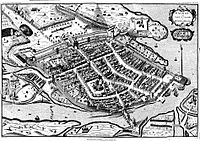
Even though organized resistance ended, the harsh surrender terms led to a period of guerrilla warfare. Bands of former soldiers, known as Tóraidhe or 'Tories,' continued to fight. They operated from rough areas like the Wicklow Mountains. They stole supplies and attacked Parliamentarian patrols. The English army responded by forcing people out of their homes and destroying crops. This caused widespread hunger, made worse by an outbreak of bubonic plague.
The last organized Irish force surrendered in Cavan in April 1653. They were allowed to go to France to serve in the French army or with the English Royalist Court in exile. Those captured after this point were executed or sent to penal colonies in the West Indies.
Ireland suffered from small-scale violence for the rest of the 1650s. This was partly due to the 1652 Act for the Settlement of Ireland. This law created a class of farmers who had lost their land. It also greatly changed who owned land in Ireland. The percentage of land owned by Protestants increased from 41% to 78% between 1641 and 1660.
Changing Sides in the War
The Irish Confederate Wars were a very complicated conflict. At least four major armies fought in Ireland. These were:
- The Royalists, loyal to King Charles.
- The Scottish Covenanters, who came to Ulster in 1642 to protect Protestant settlers after the killings in the 1641 Irish rebellion.
- The Parliamentarian army.
- The Irish Confederate army, which most people in Ireland supported.
During the wars, all these groups fought against each other at different times. To make things even more confusing, there was a short civil war between different Irish Confederate groups in 1648.
The Royalists under Ormonde fought against Irish Catholic forces from late 1641 to 1643. Their main base was in Dublin. A ceasefire with the Confederate Catholics lasted from 1643 until 1646. Then, the Confederates again fought the Royalists. After 1648, most of the Confederates and the Scots joined an alliance with the Royalists. This was the group that faced Cromwell's army in 1649. However, Ormonde's leadership in defending Ireland was not very good. By mid-1650, Irish Confederate leaders were mainly in charge of Ireland's defense.
The Irish Confederates: Formed in October 1642, the Confederation of Kilkenny was at first a rebel Irish Catholic movement. They fought against the English troops sent to stop the rebellion. However, they insisted they were fighting the king's advisors, not the king himself. They also had to fight the Scottish army that landed in Ulster. From 1642 to 1649, the Confederates controlled most of Ireland. The exceptions were east and west Ulster, Cork city, and Dublin. A ceasefire was made with the Royalists in 1643 after the English Civil War began. Talks started to bring the Confederates into the English conflict on the Royalist side. A strong Catholic group, influenced by Irish Bishops and the Pope's representative Rinuccini, appeared in 1646. This group opposed signing a peace treaty that did not recognize the Catholic Church's position in Ireland or return confiscated Catholic land. When this group removed the Confederate 'peace party' (those who favored the Royalists), the Confederates again clashed with the English Royalists. The Royalists gave up most of their positions in Ireland to the Parliamentarians in 1646. However, after new talks, an alliance was made between the Royalists and Confederates in 1648. Some Confederates (especially the Ulster army) were against this treaty. This started a short Irish Catholic civil war in 1648, where the Ulster Confederate army was supported by the English Parliament.
The Scottish Covenanters arrived in Ireland in early 1642. Their goal was to stop the uprising and protect the Scottish Protestant settlers in Ulster. They held most of eastern Ulster throughout the war. But they were greatly weakened by their defeat by the Confederates at the battle of Benburb in 1646. They fought the Confederates (with the English Parliament's support) from their arrival in Ulster in 1642 until 1648. After the alliance between the English Parliament and the Scottish Covenanters broke down, the Scottish forces in Ulster joined the Confederates and Royalists in an alliance against their former allies in 1649.
The Parliamentarian Army first gained a strong foothold in Ireland in 1644. This happened when Inchiquin's Protestant force in Cork fell out with the Royalists over their ceasefire with the Confederates. The Protestant settler forces in northwest Ireland, known as the Laggan Army, also joined the Parliamentarians after 1644. They saw Parliamentarians as the most reliably anti-Catholic English force. The city of Dublin fell to Parliamentarians in 1646. This was when the Royalists surrendered it to an English Parliamentarian army after the city was threatened by Confederate armies. In 1648, the Parliamentarians briefly supported Owen Roe O'Neill's Ulstermen after his disagreement with the Confederates. So, the very Catholic and Puritan forces were briefly allied for their own benefit. However, the Ulster Catholic army joined the Confederate-Royalist alliance after Cromwell's invasion in August 1649. The most powerful Parliamentarian force was the New Model Army. This army went on to conquer Ireland over the next four years. They enforced the Adventurers' Act 1640 by conquering and selling Irish land to pay back their financial supporters.
Aftermath of the War
The number of deaths from this conflict was huge. William Petty, a person who worked for Cromwell and did the first scientific land and population survey of Ireland in the 1650s, believed that at least 400,000 people, and possibly as many as 620,000, died in Ireland between 1641 and 1653. The actual number might be lower, but the lowest estimate is about 200,000. At that time, according to William Petty, Ireland's population was only around 1.5 million people. It is thought that about two-thirds of the deaths were civilians.
The Irish defeat led to most Catholic-owned land being taken away. This resulted in English Protestant control of Ireland for over two centuries.
The wars, especially Cromwell's conquest, were remembered for a long time in Irish culture. Gaelic and Irish poetry from after the war often talked about the lack of unity among Irish Catholics in the Confederation. They blamed the constant fighting among themselves for their failure to stop Cromwell. Other common themes included sadness for the old Irish Catholic landowning families, who were destroyed in the wars, and the cruelty of the Parliamentarian forces.
Images for kids
See also
Soldiers:
- Alasdair MacColla
- Hugh Dubh O'Neill
- George Monck
- Richard Talbot, 1st Earl of Tyrconnel
- Michael Jones (soldier)
- Theobald Taaffe, 1st Earl of Carlingford
Political figures:
- Patrick D'Arcy
- Richard Martyn
- James Tuchet, 3rd Earl of Castlehaven
- Richard Bellings
- Nicholas French
- Patrick O'Neill (Irish soldier)
- Giovanni Battista Rinuccini
- Nicholas Plunkett
- Charles II
Places:
- Clonmel
- Rathfarnham Castle
- Trim Castle
- Cahir Castle
- Narrow Water
- Ross Castle
- Rock of Cashel
- Charlemont Fort
General:
- Chronology of the Irish Confederate Wars
- Chronology of the Wars of the Three Kingdoms
- Confederate Ireland
- Cromwellian conquest of Ireland
- Irish Rebellion of 1641
- List of Irish rebellions
- List of Irish battles
Sources
- McKeiver Philip. A New History of Cromwell's Irish Campaign, (Advance Press), Manchester, ISBN: 978-0-9554663-0-4
- Hull, Eleanor (1931). A History of Ireland.
- Kenyon, John & Ohlmeyer, Jane (editors). The Civil Wars, Oxford 1998.
- Royle, Trevor (2004), Civil War: The Wars of the Three Kingdoms 1638–1660, London: Abacus, ISBN: 0-349-11564-8
- Lenihan, Padraig, Confederate Catholics at War, Cork 2001, ISBN: 1-85918-244-5
- McCoy, G. A. Hayes. Irish Battles, Belfast 1990, ISBN: 0-86281-250-X.
- Plant, David. "The Confederate War 1641–1652" , British Retrieved 23-09-2008
- Scott-Wheeler, James. Cromwell in Ireland, Dublin 1999, ISBN: 978-0-7171-2884-6


